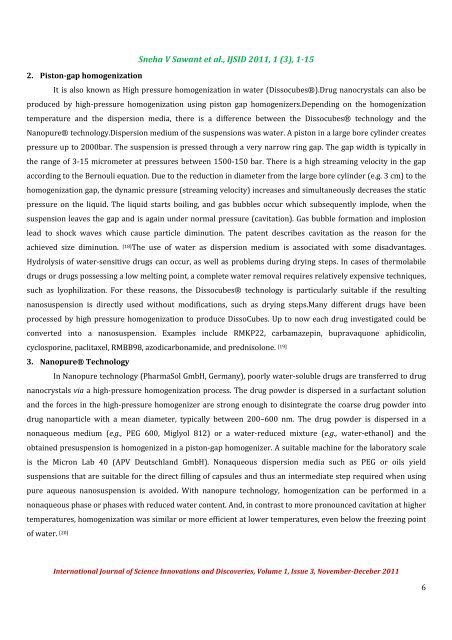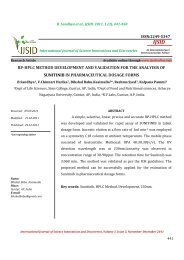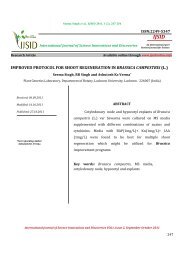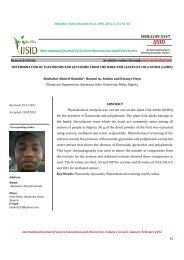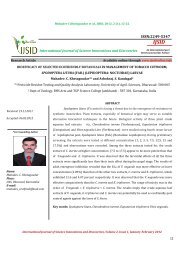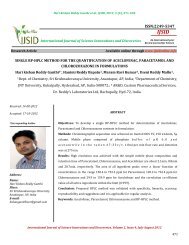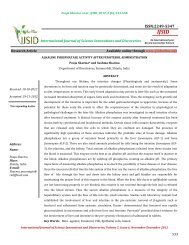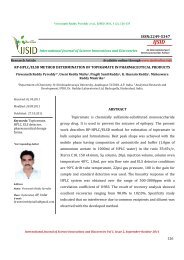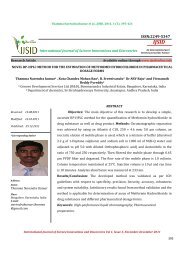drug nanocrystals: novel technique for delivery of ... - Ijsidonline.info
drug nanocrystals: novel technique for delivery of ... - Ijsidonline.info
drug nanocrystals: novel technique for delivery of ... - Ijsidonline.info
You also want an ePaper? Increase the reach of your titles
YUMPU automatically turns print PDFs into web optimized ePapers that Google loves.
Sneha V Sawant et al., IJSID 2011, 1 (3), 1-152. Piston-gap homogenizationIt is also known as High pressure homogenization in water (Dissocubes®).Drug <strong>nanocrystals</strong> can also beproduced by high-pressure homogenization using piston gap homogenizers.Depending on the homogenizationtemperature and the dispersion media, there is a difference between the Dissocubes® technology and theNanopure® technology.Dispersion medium <strong>of</strong> the suspensions was water. A piston in a large bore cylinder createspressure up to 2000bar. The suspension is pressed through a very narrow ring gap. The gap width is typically inthe range <strong>of</strong> 3-15 micrometer at pressures between 1500-150 bar. There is a high streaming velocity in the gapaccording to the Bernouli equation. Due to the reduction in diameter from the large bore cylinder (e.g. 3 cm) to thehomogenization gap, the dynamic pressure (streaming velocity) increases and simultaneously decreases the staticpressure on the liquid. The liquid starts boiling, and gas bubbles occur which subsequently implode, when thesuspension leaves the gap and is again under normal pressure (cavitation). Gas bubble <strong>for</strong>mation and implosionlead to shock waves which cause particle diminution. The patent describes cavitation as the reason <strong>for</strong> theachieved size diminution. [18] The use <strong>of</strong> water as dispersion medium is associated with some disadvantages.Hydrolysis <strong>of</strong> water-sensitive <strong>drug</strong>s can occur, as well as problems during drying steps. In cases <strong>of</strong> thermolabile<strong>drug</strong>s or <strong>drug</strong>s possessing a low melting point, a complete water removal requires relatively expensive <strong>technique</strong>s,such as lyophilization. For these reasons, the Dissocubes® technology is particularly suitable if the resultingnanosuspension is directly used without modifications, such as drying steps.Many different <strong>drug</strong>s have beenprocessed by high pressure homogenization to produce DissoCubes. Up to now each <strong>drug</strong> investigated could beconverted into a nanosuspension. Examples include RMKP22, carbamazepin, bupravaquone aphidicolin,cyclosporine, paclitaxel, RMBB98, azodicarbonamide, and prednisolone. [19]3. Nanopure® TechnologyIn Nanopure technology (PharmaSol GmbH, Germany), poorly water-soluble <strong>drug</strong>s are transferred to <strong>drug</strong><strong>nanocrystals</strong> via a high-pressure homogenization process. The <strong>drug</strong> powder is dispersed in a surfactant solutionand the <strong>for</strong>ces in the high-pressure homogenizer are strong enough to disintegrate the coarse <strong>drug</strong> powder into<strong>drug</strong> nanoparticle with a mean diameter, typically between 200–600 nm. The <strong>drug</strong> powder is dispersed in anonaqueous medium (e.g., PEG 600, Miglyol 812) or a water-reduced mixture (e.g., water-ethanol) and theobtained presuspension is homogenized in a piston-gap homogenizer. A suitable machine <strong>for</strong> the laboratory scaleis the Micron Lab 40 (APV Deutschland GmbH). Nonaqueous dispersion media such as PEG or oils yieldsuspensions that are suitable <strong>for</strong> the direct filling <strong>of</strong> capsules and thus an intermediate step required when usingpure aqueous nanosuspension is avoided. With nanopure technology, homogenization can be per<strong>for</strong>med in anonaqueous phase or phases with reduced water content. And, in contrast to more pronounced cavitation at highertemperatures, homogenization was similar or more efficient at lower temperatures, even below the freezing point<strong>of</strong> water. [20]International Journal <strong>of</strong> Science Innovations and Discoveries, Volume 1, Issue 3, November-Deceber 20116


